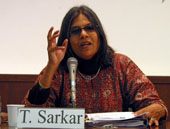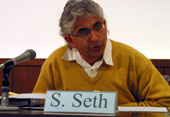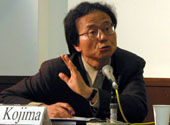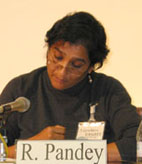

Prof. Sarkar began by noting that the predicament in India was one between teaching and writing history. History has never been as problematic as it has now, and has reached an acute point. The two sources that problematize history are post-modernism and the Hindu right.
Three kinds of post-modern influences have been significant. First, the textualized nature of accounts and historical narratives. The second critique has been of historicism, of grand narratives that move teleologically under the steam of some transcendental logic, obeying iron laws of history. The third critic of history in India is that history has developed as a separate discipline in colonial times.
Rashtriya Swayamsevak Sangh (RSS) is a cadre-based organ with strong hegemonic aims. In other words, it seeks to politically educate its chosen cadres, so that they can, in their turn, disseminate select portions of the message among the various mass fronts that they might work with. The cadres develop different addresses for the different fronts, the accents and emphases varying considerably from the one to the other. Cadres thus are, in relation to the mass fronts, teachers, and, indeed, the affiliates of the Sangh do call the Sangh itself their classroom. Teaching, therefore, is crucial to the agenda, something that is evident in the fact that the Human Resources ministry is reserved for a RSS hardliner. There is a strange relationship with the past on the part of the RSS ? there is a focus on the past, and a usable past ? the argument goes that the Hindus must have revenge in order to develop.
Hindurashtra ? or the Sangh vision of Hindu nation that seeks to replace the secular-democratic one - presupposes great excisions in collective memory as well as the production of counterfeit historical memories: experiences of poverty and exploitation to be overwritten by narratives of foreign conquests, military defeats and the ills that rulers of a different faith had allegedly done to Hindu temples, women, cows. Beyond a point, actual historical evidence for all this is thin, patchy or absent. There is, on the other hand, embarrassingly strong historical evidence to confirm the absence of the Sangh from the ranks of anti-colonial movements, of its transactions with Italian fascism and self-modeling on the politics of Nazi genocides which Golwalkar, an early leader, much admired.
Recent events in Gujarat will illustrate the Sangh methods of using and invoking the past. Last year, on 27 February, in the middle of long and violent anti- Muslim campaigns, a group of Hindu train passengers, who were also part of the campaigns, were very brutally murdered at Godhra in Gujarat where a BJP government. In greactionh, the most widespread and savage forms of violence known to our recorded history were unleashed upon Gujarat Muslims for months, with the full connivance of the government. However, Muslims who were massacred were obviously Indians, most of them so far removed for Godhra that they could not possibly have had a hand in those atrocities.
How does the Sangh propose the simultaneous demolition of accepted historical knowledge and construct its own version as authentic scholarship? Above all, the Sangh had founded schools. The first school emerged in a significant context. It was during the partition riots and their aftermath that the Sangh made its real breakthrough in North India. However, its rapid expansion was briefly stalemated as it came under a cloud of suspicion after the assassination of Gandhi. In the 1952 elections, however, the Left emerged as the major Parliamentary opposition to the Centrist politics of the Congress. At the national level of political decision-making, the Sangh vision found little purchase.
To vault over the impasse, the first thing that the Sangh did was to found a primary school at Gorakhpur in Uttar Pradesh in 1952, which rapidly spawned other Saraswati Shishu Mandirs in its wake. In 1977, Vidya Bharati was institutionalized to coordinate schools at the all-India level. By the early 1990s, it was running the second largest chain of schools in the country. Sangh schools follow the regular school board curricula and examination system. However, their schools leave their own distinctive inscription on education in a variety of subtle ways. Significantly, an entire apparatus of audio-visual and pedagogical operations was developed to intervene in remaking historical understanding in opposition to older textbooks. Revenge is used as a means of teaching.
As the authentic history of Indian civilization, such textbooks are faithful to Savarkarfs definition: Hindutva, as a continuous, historically stable cultural essence, unifies India. The landscape is bereft of all Muslim or Christian cultural or religious presence. Nor do they figure as historical actors except as fifth-columnists for foreign powers or as invaders. Muslims and Christians are not simply invaders and conquerors of the past, they are fixed in eternal postures of aggression which, today, translates as insidious and covert gestures of hidden expansionism and conquest, carried on through conversion and terrorism.
There are glaring omissions in the curriculum, however. There is no analysis of caste, poverty, gender abuses, no mention of what Hindus have done to Hindus. Nor, for that matter, of what Muslim emperors have done to Muslim peasants. Anger or even critical introspection into histories of internal, social violence is carefully excised.
The Sanghfs pedagogical method uses to a very large extent oral telling and the story format. As a pedagogical tool, especially for very small children, it is very effective. However, its dominance as a tool helps foreclose critical enquiry into the source, provenance, motivation, mode of construction of the narrated tales. The stories acquire multiple authorization.
In conclusion, we engage in such debunking of serious history, however, only when we are ignorant of the practice of history, of the spectrum of theoretical debates that emerges from an experience of that practice and which place historians within a creative and complex ambiguity that grapples with the inherent limitations and provisionality of the truth claim and the necessary discipline that still compels us towards accuracy and precision in investigation. It is out of this continuous, painful and necessary tension that rich historical understanding and description may emerge.

Prof. Seth began by stating that it was believed that everyone has a history, though not everyone has historiography. The West developed a tradition of history-writing; the Muslim world and the Chinese are admitted to have had such a tradition, albeit in an underdeveloped form; but most cultures had myths and religious epics instead of history-writing, even if they sometimes confused the former for the latter.
Let us call this complex of attitudes Reason, or more accurately, the commitment to an idea of a Reason which is singular and universal. Let us note that although this Reason has not been dethroned, it is nonetheless tottering on its pedestal. One strategy for problematizing Reason is therefore to demonstrate the contingencies and exclusions which went into its making.
Historicism, the idea that the esavagef and the Oriental were ebackwardf and belonged to a time past, even as they inhabited the present, was the main mode by and through which the reason of non-West was declared to be lesser. Historicism was what allowed a liberal like John Stuart Mill to aver that colonial India was enot yetf fit for democracy, and required an extended period of British rule and its civilizing effects before it would become so. Politically, that which was previously historicized as the pre-modern, the esurvivalf, the fragment of a past continuing into the present (and at times this included whole societies), now also participates in the rituals and practices of the modern- statehood and nationhood, citizenship, and so on.
But there have always been many, quite possibly a majority, of the worldfs population whose world is peopled by gods who act in and on the world and whose agency must be registered in any account of the world, just as there are people whose temporality as it is lived allows for their dead ancestors to directly intervene in their affairs. But how do we do so, how can we find a place for gods and spirits in modern historical consciousness and history writing? One possible method is a nominalist one, and here we can look to the law for precedents. An interesting example is that of how contemporary British law found a place for the Indian god, Siva, when Siva was named as a plaintiff in a court case. It is of course true that recognizing Siva as a ejuristic personalityf is not quite the same thing as treating him as a historical actor. To produce a history which included Siva would be incoherent.
An obvious objection to the argument so far is that if it is belief in gods and their agency, which is taken as the marker of that which cannot be coded in history, this does not serve to distinguish west from non-west. The very enterprise of representing religion within the ration(ist) code of history is a curious one.
It is often pointed out that ehistoryf is unusual in that the term for the discipline simultaneously designates its object, but history as discipline is not so innocent of preconditions. The past is not forever available to the present, a mute entity waiting for the historian to give it voice. The times of history are discontinuous and multiple, rather than continuous and singular; they are constituted by history as a code, not given in advance and simply ebroken upf into smaller segments by the historian for reasons of convenience in practicing his/her craft.
It has often been considered one of the virtues of historicism that it attends to difference. We might wonder however, whether claiming that everyone has a history, but a different one, is not to attend to difference but rather to universalize a particular way of conceiving of, relating to and recording the past. Could it be that when it comes to recognizing and representing difference, historicism is part of the problem, rather than the solution?
History-writing is one way of conceiving and relating to the past. Humanism anchors the notion that there is a single Man, but many histories of him. It is true that history-writing is increasingly imperial in its pretensions to represent all pasts, and that this is not just a matter of arrogance, but a real consequence of the transformations of the world. In India the demand that Indians write their own history was made by Bankimchandra Chatterjee in the nineteenth century , and this demand was echoed- and met- in subsequent decades. Indian nationalism was one of the main vehicles for this- it succeeded both in producing a nation, and in producing a history of that nation. History and historical consciousness are prized because they are seen as connected to citizenship, patriotism, certain narratives of social justice, secularism, and the like.
In conclusion, to pluralize reason is not to abandon reasoning; to deny that there is an Archimedean point from which one can criticize is not to call for an end to criticism. But it is to call for a reconsideration of what we think we are doing when we redescribe the past of peoples in terms which are alien to them. We have to conceive writing history in the western, modern mode not in an Imperial vein but as a translational exercise. If we take this as a regulative ideal- not a regulative ideal of a singular reason, in the Kantian sense, but as a regulative ideal of how to give reasons when confronting other modes of reasoning- it may serve to make history-writing an ethical rather than an imperial practice.

The idea of world history of a historian, Senroku Uehara (1899 ? 1975), of which I will speak of today, may seem at first rather peculiar and hard to understand. My aim is to make his idea of world history a meaningful and convincing one to the audience by the time I finish my presentation. The gthirteen world region theoryh and the gthirteenth century starting point theory,h will not be fully discussed today.
Uehara had already established his status in Japan in the field of European history with his publications demonstrating his mastery of the German empirical historicism at the highest level. Ueharafs post-war began with an awareness on how should he, both as a historian and as a citizen of reborn Japan, cope with the reality of the new world Japan faced after losing World War II. His study of world history was thus formed through post-war Japanfs unique gworld experience.h
Ueharafs search for a subjective way to grapple with the gworldh Japan faced after the defeat continued on for over thirty years. Uehara repeated his self-refinement in its course through activism, and thus developed his unique study of world history. As we read Ueharafs works chronologically, we notice that his tone changes after the revision of the U.S.-Japan Security Treaty in 1960.
When we examine Ueharafs world history, we must first unlearn what we have acquired as image and knowledge of the ghistory of the world.h We call upon and question the past to resolve the politico-economic, socio-cultural issues the gpresenth thrusts toward us, or to examine both the breadth and depth of those issues in order to confront them.
Uehara considered the issues post-war Japan faced were immeasurable in its breadth and depth within the standard of individualized national history or intercultural history based on national history. In Ueharafs case, the very impact of the issues he became aware of drove him to readdress his object of historical recognition beyond national history to world history.
Uehara had a unique idea of ghistorical spaceh brought up in his article, gThe Starting Point of World Historyh written in 1968 without the intention of being published, and the other is the idea of gpatterns of historicizing recognitionh proposed in his article, gProblems in Recognition of the Presenth written in 1963. In the former article, Uehara suggests that historical space, where present issues originate, develop, and resolve, are composed of five hierarchical dimensions.
According to Uehara, ghistoricizing recognitionh aims to historicize the living reality, which is an attitude to clarify the nature, structure, and meaning of the issues of daily lives by grasping them as and through history. Ueharafs world history is the fundamental structure of general historical recognition in general, and we must notice that ghistoricizing recognitionh is in fact the other name of his gworld history.h
To understand the meaning of ghuman history,h we must first understand the unique idea Uehara invented as the fundamental structure of world history, the gstarting point of history.h When we explore the history of the world for the range projected by the issues the present thrust toward us, we will eventually reach a point where we can no longer trace back. Uehara calls this the starting point of world history, and argues that the starting point can be variously placed in accordance with the contents and intensity of our awareness. By separating human history from world history and by categorizing human history as one of the patterns of world history, Uehara stressed that world history is a more fundamental and action-based historical image with the purpose of resolving present issues.
Uehara regards human history as a history, which systematized human development from the perspective of guncivilized or civilized,h or guncivilized to civilization.h As long as this human history is a modern European pattern of historicizing recognition, we must consider it as a subjective construct of living awareness based on the historical space and time of modern Europe. We may understand that this image of world history is the one corresponding to the urgent awareness modern Europeans needed to systematize and give meaning to their gworld experienceh when they expanded toward the world, encountered different people in unknown space, battled, and conquered them as uncivilized. If we may think in this way, we have also ascertained the effective limits of the human history. To recognize human history as one of the patterns of world history, a historical image, which is a product of historicizing recognition, would be to re-position the universalism Europe has continued to reserve for their own as one form of historic nature of the European society.
Prof. Kojima concluded with a summary of the gthirteen world region theoryh and the gthirteenth century starting point theoryh of Uehara.

Prof. Pandey began by noting that the discipline of history writing is facing
a crisis. Historians have been forced to become more critical of their own
procedures. She noted that all speakers had covered this issue.
It was noted that Prof. Sarkar had pointed out the difference between the original and its transmission. Post-modernism might have a useful lesson for historians that history does repeat itself. Robinson Crusoe, when published, was seen as a romantic, Promethean tale in India, and in Japan it acquired enormous popularity. These different readings of the same text, tell us of different responses to the West. The concern of the post-modern has been the pre-modern. Cartography has also been hijacked by the Hindu right in India, but the question arises concerning place names as whether their usage in India as religious locations actually achieve their nationalist purpose. It is necessary to know more about the conceptual categories in which the pre-moderns perceived their world.
Mr. Hokari thanked the speakers for their presentations and asked how non-secular agents are treated in history writing. He asked whether consideration should be made of the readers of a particular history, and at the time when it is being written.
Prof. Kojima responded that for Uehara, the non-human, non-secular agents were out of his realm of study, however, during the final phase of his life he attempted to incorporate such concepts.
Prof. Sarkar addressed the question of combining secular and non-secular. She stated that non-secular did not necessarily only mean non-sacred, and asked whether it would be possible to write another history concerning sacred places and events as interpreted by people who lived through them. She added that there is a collapsing of post-enlightenment with the national, and the national with the godless.
Concerning the point of grappling concepts that are created outside academia, Prof. Sarkar stated that this was a question of government or media intervention on the popular levels.
Dr. Morris-Suzuki asked a question concerning the issue of multiple ways of thinking about the past. She stated her doubts about the image of the secular West. She stated that many Western historians have religious beliefs and asked whether it would be possible to think of multiple rationalities existing in different places, but also within the same person. She addressed a question to Prof. Kojima concerning understanding of world history.
In response, Prof. Seth stated that the West is not secular. He stated that we have learned to compartmentalize our souls. As an historian, one has to follow the methods of onefs peers and therefore in the West, multiple rationalities coexist in the same person. The modern requires that personal convictions and rationalities do not cloud the writing of history.
Prof. Kojima responded that Ueharafs g13 region theoryh was incomplete, and that he had made some changes to his original theory. Originally the theory was a gten region theory.h In addition, he divided history into pre and post 13th century. After the 13th century the many diverse regions were integrated into fewer areas.
Prof. Fujiwara thanked Prof. Kojima for raising the concept of gworld historyh as it appears in Japanese history. He stated his belief that excessive focus on world history stemmed from concerns on a national level of national history in the context of world history. He asked how the situation was in India, and whether efforts were made to link Indian history with world history.
Prof. Sarkar responded that in India, from the colonial period onward, there was a preoccupation with the West as represented by Britain. She added that in medieval history, there were strong links with Southeast Asia. She added that in the case of India, it happened that accounts of world history came into the country from the colonial period onwards.
Prof. Seth posed a question back to Prof. Fujiwara whether the desire to locate was connected with Buddhism.
Prof. Yang asked about Prof. Sethfs classifications as he had used them in his paper, asking whether they were all gWesternh concepts.
Prof. Seth responded that he was not referring to nations. He explained that his argument was that what constitutes a sense of belonging is the way in which the past was constructed of people. Sense of belonging is therefore shifting constantly. He stated that his intention was not to establish categories.
Prof. Nakazato asked a question about Senroku Uehara and whether he could be considered as a Buddhist historian. He asked how historiography and the religious beliefs of Uehara could be reconciled.
Prof. Kojima responded by saying that Uehara felt that Japanese intellectuals were weak in understanding religious issues. He acknowledged that it was a difficult task to link the religious beliefs and historical writings of Uehara.
Prof. Abinales asked why the United States was not covered in the writings of Uehara.
Prof. Kojima responded that Uehara did include study of the United States, in two phases. He had studied cultural anthropology of the United States prior to westernization, and the period thereafter.
Prof. Sarkar asked how the history of gods could be written. She stated that the sacred could only be approached in certain ways and on certain occasions. She added that Dalit critique of the pantheon of Hindu gods also exists. Prof. Sarker stressed also that history of gods are written because people believe in gods. She also made a comment about the refusal of cramming.
Prof. Seth explained that his argument was that we should explore the possibility of writing histories of the gods, but then agree that it would not be possible to do so from a historical viewpoint. What he wanted to stress was the existence of non-human actors.